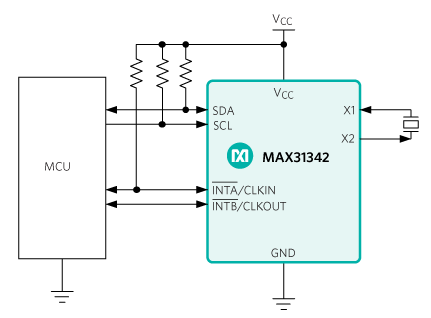要約
Nowadays, the timekeeping real-time clock (RTC) circuit is commonly integrated into the system microcontroller of portable devices. However, on close inspection, it is becoming apparent that this approach prevents the micro from ever entering an ultra-low power deep-sleep mode. In this article, we show that by using a tiny external RTC IC, this problem can be overcome, allowing portable devices to save even more power when not in use.
Introduction
“One thing you can’t recycle is wasted time.” In a world obsessed with clock watching (Figure 1) and finding new ways to save energy by reusing resources, the words of the unknown sage have, perhaps, never been more apt. Having squeezed as much energy-saving out of the “low-hanging fruit” that is the high-current components within their products, it is somewhat ironic that designers of battery-powered portable electronic equipment and IoT devices are looking to timekeeping circuits for additional power savings. Once taken for granted as a “must-have,” since it used so little power that drew little notice, the real-time clock (RTC) circuit has finally attracted the attention of energy vultures.

Figure 1. Are you guilty of clock watching?
In this design solution, we revisit the traditional integrated approach to timekeeping in portable electronic systems and show how it can waste energy even when a device is not being used. We then suggest a new approach to timekeeping in the guise of a tiny nanopower RTC IC, which breaks free from the “ever-more-integration” groupthink that many of us have become guilty of.
What is a Real-Time Clock?
Electronic devices perform tasks in response to the periodic oscillation of an electrically varying digital voltage signal or clock signal. On the other hand, human time (also known as “real” time) is measured in seconds, minutes, hours, days, months, and years. For electronic devices to perform their tasks when required by the user, they must store a digital representation of real time, which is then kept in sync using a digital clock signal. Real-time information is maintained by an RTC circuit, which is commonly integrated within the device microcontroller. A drawback of this traditional approach is that it places a lower limit on how much current is drawn by the microcontroller in power-down. Because even when in sleep mode, the micro must maintain timing information. A microcontroller in sleep mode will typically need a not insubstantial 600nA of current to keep its RTC circuits active.
Think Outside the Box—Literally!
A counterintuitive yet innovative approach to timekeeping in battery-powered devices is to use an external RTC IC that interfaces with the system micro through an I2C interface as shown in Figure 2.

Figure 2. An external RTC IC presents a counterintuitive and innovative approach to timekeeping.
Here, the main advantage is that the microcontroller can be completely powered down (or in deep-sleep mode) while the device is not in use. This RTC IC typically uses only 150nA of timekeeping current, which represents a 4x power savings when compared to using a system micro with an integrated RTC. While power savings is the main design challenge being addressed, it is important to consider the impact of an extra IC on system board space. Housed in an ultra-tiny, 8-pin WLP that measures only 1mm x 2mm (with 0.5mm pitch), this IC overcomes those concerns, as it can be easily located on even the most space-constrained boards.
This RTC IC also provides some additional benefits. Unlike other solutions which use an integrated crystal, this part uses an external crystal to generate the clock signal. This allows selection from a range of crystals with a 6pF load capacitance and an equivalent series resistance up to 100kΩ (for minimize current consumption). This is particularly beneficial given the board area constraints of wearable devices, where the shape and size of the crystal can be critical. The integrated capacitive loading ensures tight timekeeping accuracy, which could be negatively impacted if a lower tolerance external capacitor is used. It operates over a wide supply voltage of 1.6V to 3.6V. Some other useful features include a programmable square-wave output that can be used for clock monitoring and a countdown timer with repeat function.
Summary
In the inexorable pursuit of energy efficiency, circuits that were once considered too “low power” to warrant further investigation are now being examined to squeeze out every nanoamp. In this article, we have reviewed a conventional approach to electronic timekeeping using a microcontroller with an integrated RTC. We’ve also shown how it wastes power by preventing the micro from going into a “deep-sleep” mode. We then showed that by using a tiny external RTC IC that interfaces with the micro through an I2C port, power can be saved while accuracy is improved. This RTC is suitable for use in a wide range of applications such as medical wearables, point-of-sale terminals, telematics, portable instruments, portable audio, and power meters.
A similar version of this design solution originally appeared in Power Systems Design on September 01, 2020.




















